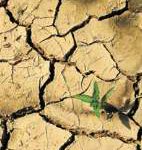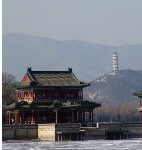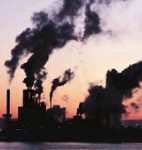Climate change will affect China, and China will affect climate change.
In its broadest usage, “climate change” refers to alterations in the earth’s global climate, or in a region’s climate, over several decades or longer time periods. Long-term, persistent fluctuations in temperature, precipitation, wind and other factors can be measured, and statistically significant variations in the average state of the climate – or in its changeability – are cited to illustrate climate change. But what is climate? It’s the long-term average of a region’s weather. Weather, then, is a short-term thing – encompassing the variety of phenomena that can occur in the earth’s atmosphere.
Climate change can occur as a result of both natural and man-made forces. The earth’s climate has suffered drastic changes in the past but climatology studies have shown that a limited number of factors have been responsible for most of the past climate change episodes. These factors include: variations in the earth’s orbital characteristics, volcanic eruptions, variations in solar output and atmospheric carbon-dioxide variations. It is the latter factor, carbon dioxide — along with other “greenhouse gases” — that are linked to the planet’s current predicament. This time it is humankind, not natural forces, that is being blamed – because of the burning of fossil fuels — for the build-up of these gases in the earth’s atmosphere. The gases, in turn, trap the sun’s heat, affecting rainfall patterns, sea levels, drought and desertification, habitat loss and much more.
While scientists prefer the term “climate change” as the more accurate description of what is happening, many people use “climate change” interchangeably with “global warming” and “the greenhouse effect”. How does it work? The greenhouse effect means that the warmth of the sun – 93 million miles, or 150 million kilometres, away — heats the planet’s surface, and that heat radiates back into space. Some of this infrared radiation is trapped in the atmosphere by greenhouse gases such as carbon dioxide and water vapour, warming the lower atmosphere, or troposphere. Some of the heat finds it way back to the planet’s surface, making it hotter than it otherwise would be. In effect, the atmosphere acts like the glass in a greenhouse.
Along with carbon dioxide and the more plentiful water vapour, greenhouse gases include methane, ozone, chlorofluorocarbons (CFCs) and nitrous oxide. “Methane is the most important of these,” says New Scientist magazine. “Its atmospheric concentration has more than doubled since pre-industrial times. Methane sources include bacteria in paddy fields, cattle guts and natural gas from landfills and rotting vegetation. Molecule for molecule, other substances are even more potent. A single molecule of either of the two most common CFCs has the same greenhouse warming effect as 10,000 CO² molecules.” CFCs drift into the upper atmosphere, or stratosphere, where their chlorine and/or bromine components destroy ozone. While it is polluting and harmful in the troposphere, ozone in the stratosphere is a natural form of oxygen, forming a protective layer around the planet and shielding it from life-threatening ultraviolet radiation.
So, what does all this mean for China? Key to the country’s relationship with climate change is its booming economy and energy sector, says Pan Jiahua, executive director of the sustainable development research centre of the Chinese Academy of Social Sciences. “Since the end of the 1980s, when climate change was brought to the global political agenda, China has gone from generating a surplus of energy to becoming an importer of oil,” Pan wrote in a 2005 article for the Science and Development Network. “The change is a symptom of a rapidly industrialising nation and comes hand-in-hand with many of the signs of a nation already suffering from the effects of climate change.” China is the second-largest emitter of greenhouse gases after the United States and recent figures indicate that China’s population and environment “are likely to suffer the effects of extreme weather events made more frequent by climate change, […] rising temperatures and changing rainfall will affect food production, and […] energy consumption — a major source of emissions — will continue to rise over the coming decades.”
“Yet,” Professor Pan adds, “China, as a developing nation, is not bound to limit its emissions under the Kyoto Protocol, and will not do so at the expense of its development. The government says developed nations must bear the responsibility for historical rises in concentrations of greenhouse gases in the atmosphere. Despite this, the Chinese government is aware of the complexities and effects of climate change. Although its primary motivation is not to align itself with international climate change policy, it is adopting measures to diversify its sources of energy and to increase energy efficiency, which could slow the steep rise of its emissions.”
As Professor Pan acknowledges, China, like the rest of the world, has been experiencing the effects of climate change. A comprehensive two-volume assessment in Chinese, Climate and Environmental Change in China (edited by Qin Dahe, Chen Yiyu and Li Xueyong), published in 2005, says the average temperature in China increased by 0.6 to 0.8 degrees centigrade over the past century, while in the past 50 years, sea levels rose by 1 to 2.5 millimetres annually.
How much do these seemingly slight increases matter? “Climate change,” writes Professor Pan, “will make China more vulnerable to damage caused by rising sea levels, drought, flooding, tropical cyclones, sandstorms and heat waves. Although a warmer climate will increase the amount of land available for farming, extreme weather could reduce agricultural yield by 10%.”
In only 50 years, China has moved from an agrarian society to one in which half of its output is industrial. With that shift – and the increase in energy consumption that comes with urbanisation, plus the fact that it still generates most of its energy from burning coal – China faces a harsh reality. Like India and Brazil, the country is expected to be a major voice in future international climate change negotiations, in the post-Kyoto period beginning in 2012.
“Probably the only way China will take on emissions restrictions is if it can implement clean energy technologies that will allow its economy to keep growing swiftly,” writes Maya Papineau in the online journal of the Centre for International Climate and Environmental Research (Cicero). “However, technology transfer from the developed nations, on an unprecedented scale, is likely the only way to bring about serious cutbacks while preserving economic growth. In this respect, most of the challenge lies with the industrialised nations to agree on a framework to efficiently transfer cleaner energy technologies to the developing world.”
“As post-Kyoto negotiations evolve,” writes Professor Pan, “many feel that China will have to consider committing to reducing emissions after 2012. … [i]t is in China’s interest to help mitigate the effects of climate change both internationally and domestically. Cooperating will help China become more energy efficient and use more energy from renewable sources. Spurred on by this, China is more likely to participate in global initiatives on energy efficiency, development of renewable energy, and carbon capture and storage, than to commit to reducing its emissions.”
Still, he points out, the country has a long way to go on its development path.



